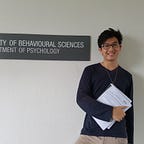Reading Notes: “This is Me” From On Becoming a Person
This first chapter begins with Carl Rogers’ own understanding of himself, as a psychologist with a primary interest in psychotherapy (probably one of the first psychologists to actively study the process of therapy using scientific methods). He briefly described the essence of his person centered philosophy, and following his intuition, decided to visit his history to contextualize the origins of his thoughts.
Here, three very important themes of his early days stood out to me: strictness, religion, and farming.
a. It is hard to miss that he grew up in an environment that conveyed affection and love through discipline and control. This resonated a bit with me as I too experienced very strict education and parenting in my early years, and had a lot of anxiety trying to keep up with the expectations of others. This experience is probably where he got the concept of ‘conditions of worth’ from.
b. Carl Rogers was not shy about his atheism, and that was one of the initial reasons his ideas resonated with me. Most of my peers during my psychology undergraduate were Christians, and often brought up Christianity as a framework of growth and unconditional regard. The fact that Rogers advocated for these humanistic values while being openly atheist sealed him permanently as one of the most important intellectual figures for me. This means to me that treating others with unconditional positive regard is valid even without adhering to some religious dogma. It is also in this chapter which Rogers described the process of him outgrowing his religion, noting it as the process which he truly become an independent person.
c. His upbringing in scientific agriculture is also noteworthy, because it explains his unusual affinity with science as a whole, which is something we tend to not give him enough credit for. This would inspire him greatly to approach matters of life using science (such as experimental methods, hypothesis testing, and causal inferences) and understand the growth of an individual as an inherently organismic process not unlike the growth of a plant.
There was also another important experience was also described here, where him and a group of students petitioned for a credited seminar where the curriculum was composed of their own questions and doubts. He found this unorthodox experience very satisfying, which probably also inspired his approach to therapy and education. There is something inherent in human nature that allows a class can be ran without theory and curriculum, yet be engaging and educational at the same time.
Rogers himself also emphasized that research has been steadily growing more important to him. In his words, he found that in therapy he could let himself go subjectively, while through research he examined this subjectivity with an objective lens, using science to ensure that he had not been deceiving himself. From here one can see his valuing of an healthy interplay between science and therapy. Perhaps his conceptualization of the Person-Centered Approach might not just be a modality of therapy, or a method for social engagement. The same spirit might carry over to how one might view and practice science.
While this chapter doesn’t go into the finer points of his life and what makes PCT works, it sets the tone for his book. It outlines important life events for him, shown his tentative attitude towards facts in his writing tone, and outlined the scope of his book and philosophy.
